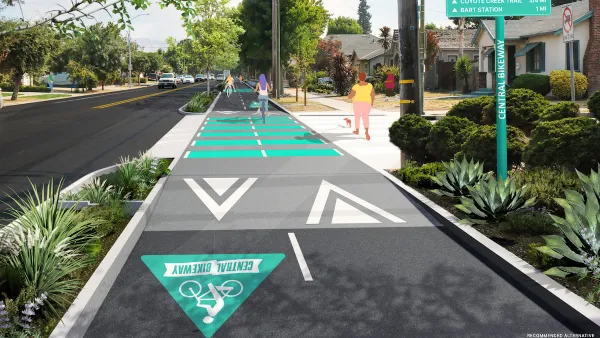The most dangerous air pollution is not smog and is barely known by the public, writes Bill Adams, editor of UrbDeZine. Line-source particulate matter air pollution could change the way the public thinks about road projects and gas powered cars.
Roughly one-third of the U.S. population unknowingly lives, works, or goes to school within a toxic auto-emission zone that has nothing to do with smog. These zones are defined by key distances and other factors that shape an ultra-fine particulate matter plume near busy roadways, writes Bill Adams, editor of UrbDeZine. Within these zones are elevated rates of death and a wide array of conditions that range from heart disease to autism.
Moreover, these auto-emission zones have significant social justice implications, adds Adams, because of the disproportionate number of poor and ethnic minorities that reside within them. He writes:
"Suburban expansion creates a demand for road expansion through existing neighborhoods. Lower income neighborhoods and ethnic minority populations least often wield the political influence necessary to resist road expansion projects. Additionally, multifamily and affordable housing is more likely to be sited near high traffic areas than is more expensive detached housing. More recently, the construction of high density “transit oriented developments” (TODs), which are intended to reduce auto reliance and which often include affordable housing, are frequently sited near high traffic areas."
Adams goes on to posit:
"Perhaps, if the public was more aware of the direct and unequal health impacts of high-traffic roadways, transitioning from roadway expansion to transportation alternatives would receive more urgency."
FULL STORY: What is a safe distance to live or work near high auto emission roads?

Planetizen Federal Action Tracker
A weekly monitor of how Trump’s orders and actions are impacting planners and planning in America.

Silicon Valley ‘Bike Superhighway’ Awarded $14M State Grant
A Caltrans grant brings the 10-mile Central Bikeway project connecting Santa Clara and East San Jose closer to fruition.

Amtrak Cutting Jobs, Funding to High-Speed Rail
The agency plans to cut 10 percent of its workforce and has confirmed it will not fund new high-speed rail projects.

How a Truck Tax Could Save the Highway Trust Fund
The freight trucking industry is a prime candidate for a mileage tax that would boost road maintenance revenue.

Metro Data: LA Transit Ridership Fell Due to Immigration Raids
Metro ridership data reveal how the ICE raids sweeping Los Angeles are disrupting daily life and impacting how people move around the city.

Portland Transit Agency Announces Planned Service Cuts
TriMet says the state legislature’s failure to pass a bill that would have funded transit means it will have to make significant service cuts over the next several years.
Urban Design for Planners 1: Software Tools
This six-course series explores essential urban design concepts using open source software and equips planners with the tools they need to participate fully in the urban design process.
Planning for Universal Design
Learn the tools for implementing Universal Design in planning regulations.
Yukon Government
Caltrans
New Jersey Institute of Technology
Mpact (founded as Rail~Volution)
City of Camden Redevelopment Agency
City of Norman, Oklahoma
City of Portland
City of Laramie





























